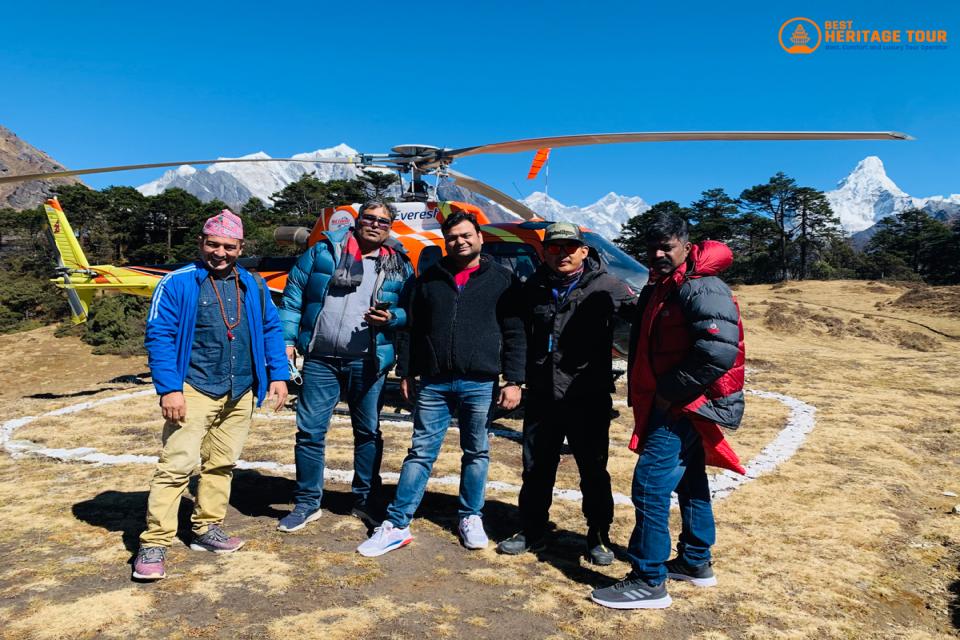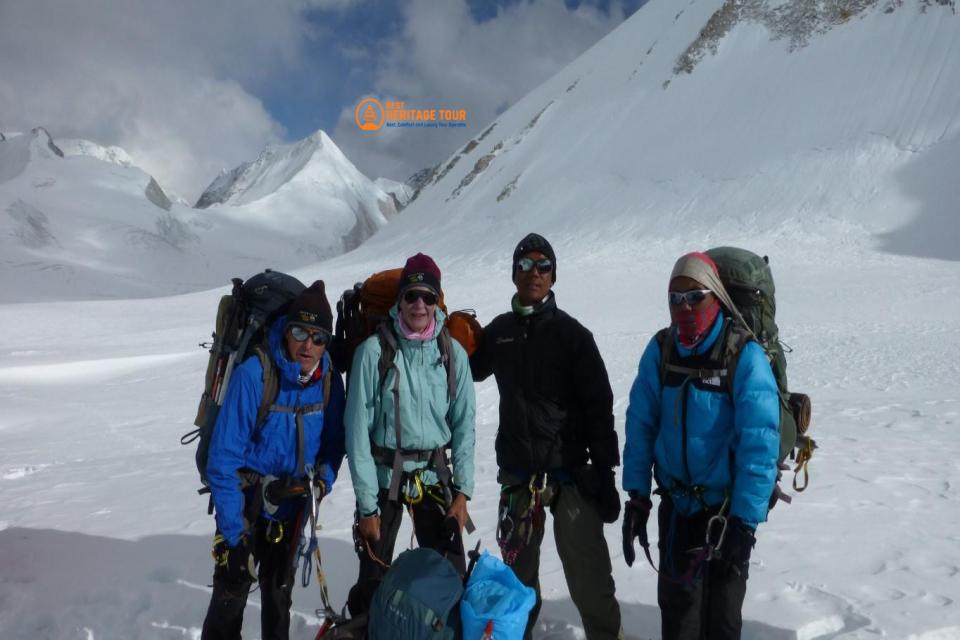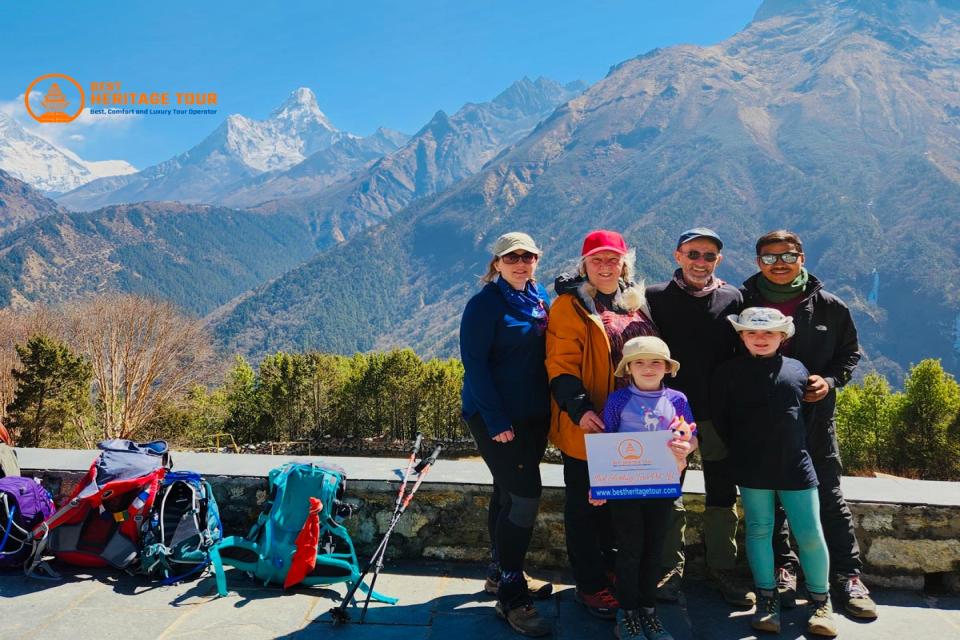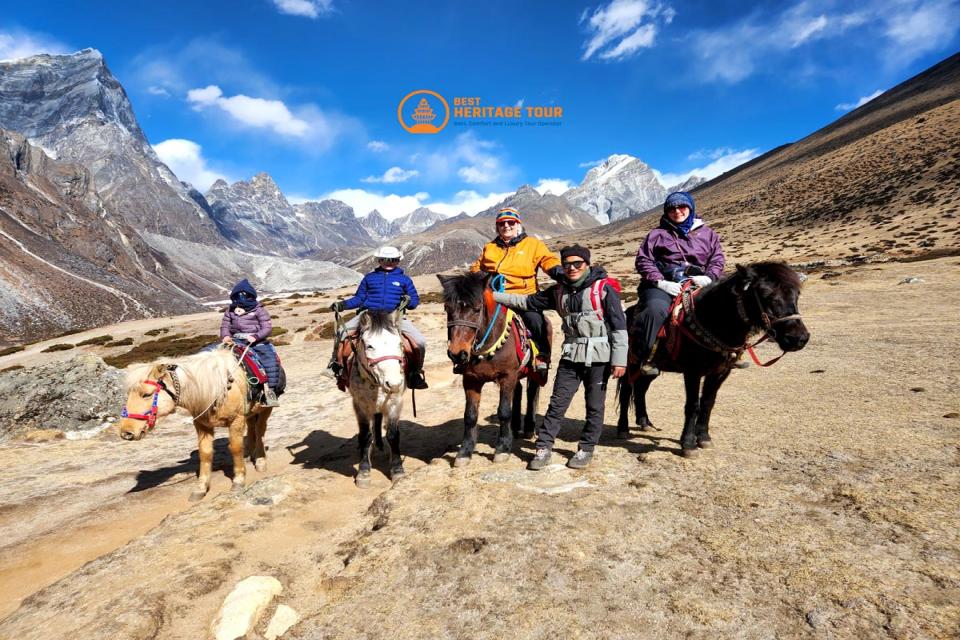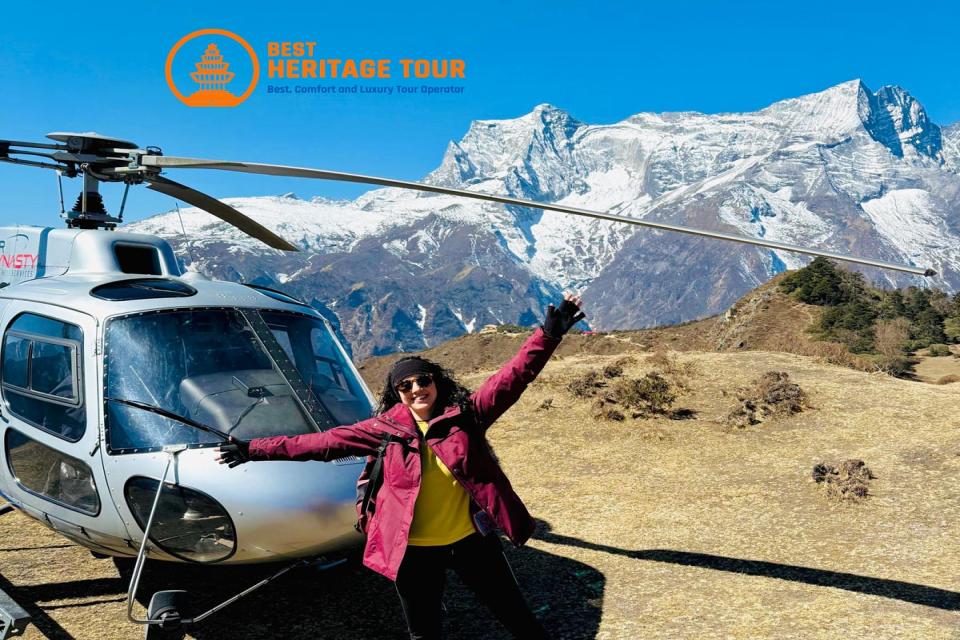The Everest Base Camp Trek is more than just a trail - it's a dream, a challenge, and a life-changing Himalayan journey that thousands of trekkers from around the world undertake each year. If you’re planning to trek to Everest Base Camp (EBC) in 2026, this comprehensive guide will give you every detail you need: cost, itinerary, best time, difficulty level, permits, packing list, training tips, altitude information, and more.
With Nepal’s tourism experiencing steady growth and 2026 expected to be one of the busiest years for Himalayan trekking, preparing early will ensure a smoother, safer, and more fulfilling adventure. As a Nepali travel expert and professional trekking company - Best Heritage Tour who has led hundreds of trekkers to EBC, we’ve crafted this guide to help you plan with confidence.
Why Trek to Everest Base Camp in 2026?
The year 2026 is shaping up to be a special one for Himalayan trekking. Nepal is investing heavily in tourism recovery, infrastructure improvements, lodge upgrades, and flight management systems. This means a safer, more comfortable, and better-organized trekking environment for visitors.
Here’s why 2026 is the perfect year for your EBC adventure:
1. Improved Trails & Teahouse Facilities
During 2024-2025, major sections of the Khumbu Valley have undergone maintenance. Many teahouses now offer:
-
Better insulation
-
Hot shower systems
-
Solar-powered rooms
-
WiFi availability in more areas
-
Enhanced hygienic food menus
So your 2026 trek = a much more comfortable stay along the route.
2. Better Flight Management to Lukla
The Civil Aviation Authority of Nepal has been upgrading communication systems and implementing safer weather-controlled flight windows. Expect:
-
Better flight frequency
-
More reliable schedules
-
Enhanced safety measures
3. More Trained Guides
With Nepal promoting responsible and safe trekking, there’s a growing number of:
-
Certified trekking guides
-
Wilderness First Aid-trained personnel
-
Updated safety protocols
4. Increased Trekker Support Services
Services such as:
-
Helicopter rescues
-
Altitude clinics
-
Trekking gear rentals
-
Satellite communication
… have improved dramatically.
All these factors make 2026 one of the most promising years for an Everest Base Camp Trek.
Everest Base Camp Trek Overview (For 2026)
Here’s a quick snapshot:
|
Feature |
Details |
|---|---|
|
Total Duration |
12-14 days (standard itinerary) |
|
Max Elevation |
5,364 m (EBC) / 5,545 m (Kala Patthar) |
|
Trek Difficulty |
Moderate to Difficult |
|
Accommodation |
Tea houses |
|
Transportation |
Flight Kathmandu-Lukla |
|
Best Time |
Spring (Mar-May) & Autumn (Sep-Nov) |
|
Permits Required |
Khumbu Pasang Lhamu Rural Municipality Permit, Sagarmatha National Park Permit |
|
Average Daily Walk |
5-7 hours |
|
Suitable For |
Physically fit trekkers |
How Much Does the Everest Base Camp Trek Cost in 2026?
EBC trek costs vary depending on:
-
Group size
-
Trekker’s preferences
-
Season
-
Whether you book with a local or international company
-
Choice of accommodations
Below is a realistic cost breakdown for 2026.
1. Total Estimated Cost (Package)
|
EBC Trek Package (2026) |
Price Range |
|---|---|
|
Standard Group Trek |
USD 1,200 - 1,600 per person |
|
Private Trek (2-6 pax) |
USD 1,450 - 1,900 per person |
|
Luxury EBC Trek |
USD 2,500 - 3,800 per person |
2. Cost Breakdown
Flight Costs
-
Kathmandu to Lukla Round Trip: USD 360 - 450
Prices fluctuate depending on the season.
Permits
-
Sagarmatha National Park Permit: NPR 3,000 (approx. USD 25)
-
Khumbu Pasang Lhamu Rural Municipality Permit: NPR 2,000 (approx. USD 18)
Guide & Porter
-
Guide: USD 30 - 35 per day
-
Porter: USD 25 - 30 per day
Accommodation
-
USD 6 - 15 per night (standard teahouse)
-
Higher elevation = slightly higher cost.
Food
-
USD 25 - 35 per day
-
Dal Bhat, pasta, soups, potato dishes, tea, porridge, etc.
Extras
-
WiFi, battery charging, hot showers = USD 2 - 8 depending on the village.
Overall Budget for Independent Trekkers
If trekking with your own guide:
USD 1,000 - 1,500 total (medium comfort & safety standards)
Best Time to Trek Everest Base Camp in 2026
1. Spring (March-May) - Best for Weather & Views
Pros:
-
Clear mountain views
-
Blooming rhododendrons
-
Warmer temperatures
-
High trail energy
2. Autumn (September-November) - Best Overall Season
Pros:
-
Crystal clear skies
-
Stable weather
-
Perfect for photography
3. Winter (December-February) - Less Crowded
Pros:
-
Quiet trails
-
Incredible sharp views
Cons: -
Very cold
-
Some lodges may close
4. Summer/Monsoon (June-August) - Least Preferred
Pros:
-
Lush landscapes
Cons: -
Rainy conditions
-
Flight delays
-
Leeches in lower altitudes
For most trekkers, April-May and October-November 2026 are ideal.
Everest Base Camp Trek 2026 - Detailed 14-Day Itinerary
This is the classic and highly recommended route for altitude safety.
Day 1: Arrival in Kathmandu
-
Explore Thamel
-
Final gear check
-
Meet your trekking guide
Day 2: Fly to Lukla (2,840 m) & Trek to Phakding (2,610 m)
Walking: 3-4 hours
The flight to Lukla is one of the most scenic short flights in the world. Begin trekking along the Dudh Koshi River.
Day 3: Trek from Phakding to Namche Bazaar (3,440 m)
Walking: 6-7 hours
Highlights:
-
Crossing suspension bridges
-
First views of Everest from Top Danda
-
Enter Sagarmatha National Park
Namche Bazaar is the Sherpa capital-a vibrant trading town.
Day 4: Acclimatization Day in Namche
Acclimatization hike to:
-
Everest View Hotel
-
Syangboche Airstrip
-
Khumjung Village
Spend the rest of the day exploring cafes, bakeries, and museums.
Day 5: Namche to Tengboche (3,860 m)
Walking: 5-6 hours
Tengboche Monastery is the spiritual heart of the Khumbu region.
Day 6: Tengboche to Dingboche (4,410 m)
Walking: 5-6 hours
The trail passes through forests, rivers, and open valleys with Ama Dablam towering over you.
Day 7: Acclimatization Day in Dingboche
Optional hikes:
-
Nagarjun Hill (5,100 m)
-
Imja Valley
This is crucial to avoid altitude sickness.
Day 8: Dingboche to Lobuche (4,910 m)
Walking: 5-6 hours
This stretch takes you past the climbers’ memorial at Thukla Pass-an emotional point honoring Everest climbers.
Day 9: Lobuche to Gorakshep (5,164 m) & Everest Base Camp (5,364 m)
Walking: 7-8 hours
The big day! Reach Everest Base Camp, take photos, explore the glacier terrain, then return to Gorakshep for the night.
Day 10: Hike to Kala Patthar (5,545 m) & Trek to Pheriche
Walking: 7-8 hours
Kala Patthar offers the best sunrise view of Everest-an absolute highlight.
Day 11: Pheriche to Namche Bazaar
Walking: 6-7 hours
Gradually descend through Tengboche.
Day 12: Namche Bazaar to Lukla
Walking: 6-7 hours
Your last night in the Khumbu-time to celebrate with Sherpa hospitality.
Day 13: Fly back to Kathmandu
Free day for rest, souvenir shopping, or exploring heritage sites.
Day 14: Final Departure
End of the legendary EBC experience.
How Difficult is the Everest Base Camp Trek?
Difficulty Level: Moderate to Difficult
Challenges include:
-
Long walking days
-
Steep ascents
-
High altitude
-
Cold temperatures
-
Basic accommodation
But you do NOT need:
-
Technical climbing skills
-
Prior mountaineering experience
Anyone with moderate fitness and preparation can complete EBC safely in 2026.
Physical Training Guide for EBC 2026
Start training at least 8-12 weeks before your trek.
Focus on:
1. Cardiovascular exercises
-
Running
-
Hiking
-
Cycling
-
Stair climbing
2. Strength training
-
Legs: squats, lunges
-
Core: planks
-
Back & shoulders (for backpack carrying)
3. Practice hikes
Aim for 5-6 hour hikes with 8-10 kg backpack.
Packing List for Everest Base Camp Trek 2026
Here’s what you must carry:
Clothing
-
Base layers
-
Fleece jacket
-
Down jacket
-
Waterproof jacket
-
Trekking pants
-
Thermal innerwear
Footwear
-
Quality trekking boots
-
Warm socks
-
Sandals for lodges
Accessories
-
Trekking poles
-
Sunglasses (UV protection)
-
Warm gloves
-
Sun hat
-
Buff or neck gaiter
Gear
-
Sleeping bag (-15°C recommended)
-
Headlamp
-
Power bank
-
Reusable water bottle
Personal Items
-
Sunscreen
-
Lip balm
-
First aid kit
-
Diamox (for altitude) - Consult doctor before use.
Altitude Sickness on EBC: What You Should Know
Altitude sickness (AMS) is the biggest challenge.
Common Symptoms
-
Headache
-
Loss of appetite
-
Nausea
-
Difficulty sleeping
Prevention
-
Drink 3-4 liters of water daily
-
Hike slowly
-
Spend acclimatization days wisely
-
Avoid alcohol
When to descend
If symptoms worsen:
-
Extreme dizziness
-
Difficulty breathing
-
Loss of coordination
Your guide will help you assess risk and arrange rescue if needed.
Food & Accommodation on the EBC Route
Accommodation
-
Clean teahouses
-
Twin-sharing rooms
-
Shared bathrooms
-
Meals served in warm dining halls
Food Options
-
Dal Bhat
-
Fried rice
-
Pasta
-
Thukpa
-
Potato dishes
-
Pancakes
-
Tea/coffee/hot chocolate
Dal Bhat is always the best option for energy.
Internet, SIM Cards & Charging
Internet
-
Everest Link WiFi cards available from Namche onwards
-
Cost: USD 6-12 per package
Charging
-
Solar/battery charging for USD 2-5
SIM Cards
-
Ncell & NTC work up to Tengboche / Dingboche (not throughout)
Why Choose a Local Trekking Company for EBC 2026?
Local companies like Best Heritage Tour offer:
-
Experienced licensed guides
-
Emergency support
-
Better pricing
-
Local knowledge of culture & terrain
-
Personalized care
International agencies usually outsource to local teams anyway-so choosing local ensures authenticity and fair pricing.
Conclusion: Start Planning Your Everest Base Camp Trek 2026 Today
The Everest Base Camp Trek 2026 promises to be an unforgettable adventure-filled with Himalayan beauty, Sherpa culture, spiritual monasteries, breathtaking views, and life-changing moments. Whether you’re a seasoned traveler or a first-time trekker, this journey will reward you with memories that last forever.
As Nepal continues to enhance its trekking infrastructure, 2026 is the ideal year to explore Everest with comfort, safety, and authentic local guidance.
If you’re ready to plan your trek - or simply want expert advice - Best Heritage Tour is here to guide you every step of the way.
Contact Best Heritage Tour - Your Trusted Local Trekking Partner
Phone / WhatsApp / Viber: +977-9851149197 / +977-9810043046
Email: info@bestheritagetour.com / bestheritagetour@gmail.com
Website: www.bestheritagetour.com
Office Address: Thamel Marg, Kathmandu, Nepal
Author: Best Heritage Tour
Date: 20th November, 2025



